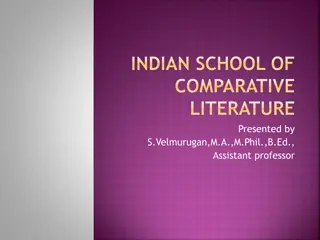Indian Economic Planning: Five Year Plans in India
Indian Economic Planning has been guided by the implementation of Five Year Plans since the establishment of the Planning Commission in 1950. These plans aimed at economic development, employment generation, self-sufficiency, social welfare, and regional development. While the plans achieved significant milestones such as the growth of the public sector and modernization of the economy, they also faced challenges including inappropriate planning models, failures in employment generation, and inadequate increase in living standards. The transition from the Planning Commission to NITI-Ayog marked a significant shift in India's planning strategy.
Download Presentation

Please find below an Image/Link to download the presentation.
The content on the website is provided AS IS for your information and personal use only. It may not be sold, licensed, or shared on other websites without obtaining consent from the author. Download presentation by click this link. If you encounter any issues during the download, it is possible that the publisher has removed the file from their server.
E N D
Presentation Transcript
COURSE: B.Sc. (PROGRAMME) IN ECONOMICS PAPER NAME INDIAN ECONOMIC PLANNING AND POLICY ISSUES TOPIC FIVE YEAR PLANS IN INDIA YEAR- FIRST SEMESTER-4 SESSION -2021-2022 DATE OF LECTURE: 8/03/2022 PREPARED BY DR. KAMALIKA CHAKRABORTY ASSISTANT PROFESSOR (DEPARTMENT OF ECONOMICS) KHATRA ADIBASI MAHAVIDYALAYA, BANKURA, WEST BENGAL
Planning Commission was set up on 15 March 1950 and the plan era started from 1 April 1951 with the launching of the First Five Year Plan (1951-56) Objectives of Five Year Plans in India are: Economic Development Increased Levels of Employment Self Sufficiency Economic Stability Social Welfare and Provision of Efficient Social Services Regional Development Comprehensive and Sustainable Development Reduction in Economic Inequality Social Justice Increased Standard of Living
List of 5 year plans in India Annual Plans (1990 1992) First Plan (1951 1956) Eighth Plan (1992 1997) Second Plan (1956 1961) Ninth Plan (1997 2002) Third Plan (1961 1966) Tenth Plan (2002 2007) Plan Holidays (1966 1969) Eleventh Plan (2007 2012) Fourth Plan (1969 1974) Twelfth Plan (2012 2017) Fifth Plan (1974 1978) Rolling Plan (1978 1980) Sixth Plan (1980 1985) Seventh Plan (1985 1990)
ACHIEVEMENTS OF FIVE YEAR PLANS Replacing the planning commission by NITI-Ayog. 1. Increase in NI 2. Increase in PCI 3. Development of economic infrastructure(transportation, communication, power generation etc.) 4. Development of social infrastructure ( education, health etc.) 5. Development of basic and capital goods industries 6. Development in agriculture sector and green revolution 7. Growth of the public sector 8. Modernization of the Indian economy 9. Improvement in the quality of the life of the people 10. Increase in investment (physical capital and human capital) 11. Distributive Justice Can be analyzed in 3 sectors Agrarian sector Industrial sector Balanced regional development 12. Self-reliance
FAILURES OF FIVE YEAR PLANS 1. Inappropriate plan modeling 2. Institutional failures goal confusing mis-targeting negative loops 3. absence of financial strategy 4. over emphasis on investment 5. neglect of employment generation 6. failures in industrial strategy 7. neglect of social justice 8. implemental failures 9. absence of a link between priorities and policies 10. no substantial increase in standard of living 11. rise in prices 12. increase in unemployment 13. inadequate increase in production 14. inadequate development of infrastructure 15. inefficient administration 16. high capital output ratio( it is the amount of capital needed to produce one unit of output























